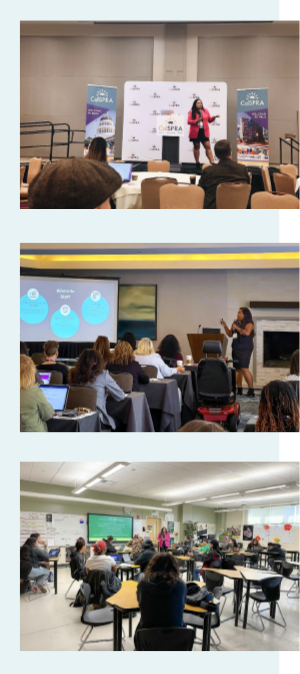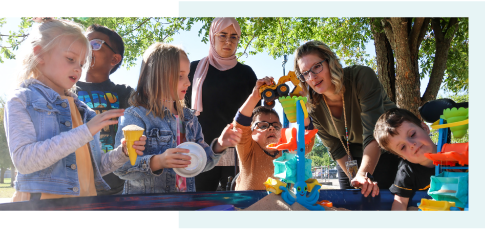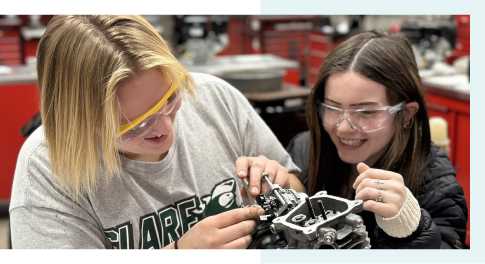Who's Telling Your Story?
Teachers are the heart of your district brand, but how can you encourage them to share their stories?


Who’s Telling Your Story?
How to Turn Teachers Into Ambassadors for Your Brand
In so many districts all over the country there are, paradoxically, too many good stories to tell and not enough stories to share. Does that sound like your district, too? It’s no wonder: Your comms team can’t bend time and space to cover every single outstanding moment happening in every school every day. But have you considered asking your teachers to help?
Think about it—teachers see the small day-to-day moments that make your schools special. They have personal access to the classroom stories that someone at the district level might struggle to capture. What’s more, our recent original survey “What Parents Want” found that parents trust communications from their child’s teacher over principals and central office staff. This could indicate that parents may pay more attention to stories shared by teachers than to those shared by district personnel.
As a school leader, you might be hesitant to ask teachers to take on more work because they’re already spread so thin. But teachers who take part in the storytelling process have a lot to gain from it—not least of which is strengthening your district brand. And your teachers might be more willing to help than you think. In our 2022 survey “Who Speaks For Your Brand,” we learned that most teachers and non-teaching staff see it as part of their jobs to improve their district’s reputation.
But how can you make storytelling even more attractive to teachers? Let’s talk about three ways school districts across the country have done just that.
Offer professional
development credits.
At the start of 2020, Lynette White was the executive assistant to the new superintendent of Santa Ana Unified School District in California. Santa Ana didn’t have a public information officer at the time, so the super asked the office assistants if anyone would be willing to help manage the district’s social media accounts. White was the first to raise her hand. “Before Santa Ana, I ran social media at the school level. Even when I was a classified employee, I was also responsible for the school’s communications,” she says.
That was just a couple of months before the pandemic hit. Suddenly, stay-at-home orders meant people were even more online than usual, and therefore paying even more attention to social media. However, the lack of in-person classes and events made it extremely difficult to capture special moments—and instill a strong sense of community among stakeholders.
White understood the difficulty and importance of keeping up a strong social media presence at such a singular moment in time. But with 50 campuses in the district, she knew she needed help gathering and sharing stories. “We were all on TikTok and Instagram. We were seeing all these influencers become brand ambassadors for everything. And I thought, Why can’t we do that for education?” she tells us. “So with the blessing of the superintendent, I started developing courses.”
White’s vision was to get at least one volunteer from every school to be that building’s social media point person, each of whom would be in charge of collecting and posting content to their school’s accounts. She described the brand ambassador program to teachers and staff as a professional development opportunity—a chance to connect with the communities they cared about and reinforce their schools’ reputations.
More than 100 people signed up initially, but soon more joined—which meant there would be multiple brand ambassadors at each building. White was thrilled. She started by offering four basic modules focused on how to use the most prevalent social media platforms. White gathered feedback from trainees and designed additional lessons in response. By the end of the first year, she had developed 10 modules.
After the first year she revised the course so that the very first module became brand training—showing trainees how to align their storytelling to the district’s vision, mission and values. Additional lessons ranged from capturing high-quality photos and video to creating content calendars to using Canva—whatever her “students” requested to learn.
For the teachers and staff at Santa Ana who elected to take White’s course, the value of becoming a brand ambassador was obvious. Not only were they learning new skills, but they were contributing to the success of their school and district brands by reinforcing the value of the education they provided. And there was an added benefit to these lessons White didn’t foresee—they brought people from different schools together. The program created a tight-knit community of brand ambassadors within the larger district community.
No longer with Santa Ana, White is now a full-time social media consultant to several school districts, and she offers her brand ambassador course online. She’s also able to provide an even bigger incentive to teachers and staff who sign up for her course—10 hours of PD credit. White’s is not the only course that offers PD credits for social media training, which means school districts have several options for implementing a similar brand ambassador system in their schools. And if teachers are allowed to count courses such as these for their PD requirements, they’re not actually an additional ask of their time.
We all know teachers have incredible stories to tell, but White says sometimes they need a little coaxing to tell them. “Teachers in public education are incredibly humble so they don’t talk about all the great things that they do every day,” says White. “To them it’s normal. It’s just what they do.” White’s brand ambassador course not only shows teachers how to talk about their work—it also shows them how valuable that work is.
And for those teachers who hope to move into leadership roles someday, becoming a brand ambassador is preparation for the future. “The higher they are, the more they’re expected to be a storyteller for that district,” says White. “So why not give them the building blocks early on to be able to do so?” Now that’s professional development.

Offer a stipend.
AJ Graffeo, director of communications at Putnam City Schools in Oklahoma, helped start a paid Communications Site Rep program when he was still a comms specialist at the district. “We just weren’t getting a lot of information funneling up from the schools,” says Graffeo, “so we wanted someone to be the designated go-to person at every school. That way we could have a direct line to everyone at all 27 sites, and they could have a direct line back to us.”
So Putnam City decided to use Elementary and Secondary School Emergency Relief (ESSER) funds to start their Communications Site Rep program. The principals at each building were tasked with selecting one person to be the site rep for that school—often someone who had already demonstrated an interest in social media. In exchange, each rep was offered a stipend to perform their duties.
The chosen reps were put in charge of managing three avenues each: social media, the website and the public calendar. In addition, they were asked to funnel two stories per month to the district comms team. Graffeo brought everyone together for an orientation at the district office that included brand training, tips for getting more engagement on social media and instructions for operating their school websites on the backend. Then Graffeo started a group chat with all 27 reps where he could continue to offer support when they needed it.
Those site reps, in turn, could ask other staff members in their buildings to help generate story ideas. “They definitely trained their colleagues—you could tell some more than others—because those schools were really getting the story out,” Graffeo says.
In addition, Graffeo gave reps guidance about what kinds of content to collect from their colleagues. He told them to showcase not just special events like a school play or a football game, but also day-to-day moments like a first grade math lesson involving Skittles. “We wanted our content district- and schoolwide to really be an inside look into what’s happening in the classrooms,” he says. “There’s so much negative rhetoric going on about public schools now, so we wanted to show that that’s not what’s happening.”
Putnam City’s stipend started at a flat rate, but after one year they realized that secondary school reps had to do a lot more work than elementary ones. “There’s just more going on at the high school. So the next year it was tiered to compensate those that were doing a lot more work,” Graffeo says. While the district Communications Site Rep program ended in 2024 with the discontinuation of ESSER, Graffeo says many principals have elected to keep their designated site reps with stipends they are funding with building money—an indicator of just how effective the program was.
“I think it is very useful, especially for big districts. I felt like this really built that bridge between my office and the different sites,” Graffeo explains. He also says that because of the system it created, staff members are more readily sending content to his team or telling comms about building-level events so they can attend and capture the content for themselves.
“I was a teacher who ran my school’s social media, and I loved it,” he says. His point beingthere are probably plenty of teachers like him who would be willing to help. You just have to look for them—and offering them a little pocket change doesn’t hurt.

Make it easy to contribute.
Clare-Gladwin Regional Education Services District (CGRESD) provides itinerant support staff to five districts in central Michigan and operates both a special education and career and technical school. Social media wasn’t necessarily on Superintendent Dr. Tara Mager’s radar, but when she saw a presentation about “collective authorship” given by fellow Michigan district Saginaw ISD, she decided she wanted to bring it to CGRESD.
Saginaw ISD uses the term “collective authorship” to describe their framework for empowering dozens if not hundreds of voices to play an active part in telling their district’s story. “The idea is, it’s not through my lens or yours. It’s through the lens of the staff who are directly involved in these interactions. Superintendent Mager really appreciated that vision. She liked empowering the employees,” says Barbara Cataldo, director of communications at CGRESD.
Saginaw’s collective authorship initiative, “Our Story,” allows every staff member to post to the district website’s Live Feed and social media via a handy-to-use app powered by Apptegy. With Saginaw’s guidance, Cataldo developed training materials to implement “Our Story” at CGRESD. Now, after completing just a four-minute training exercise, CGRESD staff members gain access to the district’s online content through the app. You read that right: In just four minutes, any staff member in the district can become a certified author for the district website and social media. Cataldo and a colleague review every post, helping ensure it’s all accurate, appropriate and aligned with the organization’s values.
At the start, one of the teachers’ big concerns was around protecting student privacy. To address this, Cataldo developed guidelines for posting photos of children. As more questions came in, Cataldo created an FAQ to address them and other issues that might arise. She also gave staff a handy one-pager with content ideas and posting tips. For those staff members who are still hesitant to post, Cataldo offers in-person training. “I help them download the app to their phones and guide them through creating a post, then we publish it together,” she says. “Once they go through the entire process, they realize just how easy it is.”
Even with the additional time she has spent on in-person training, Cataldo says collective authorship has been a huge time-saver for her and her team. Now, CGRESD employees post at least two to three stories a day about topics or events that Cataldo might not have thought to highlight, such as a teacher’s retirement or classroom collaboration. And the employees reap plenty of benefits from it, too—they get to express themselves, share stories that are meaningful to them, and strengthen their bond with both stakeholders and each other. “They’re posting items that are important to them. They’re highlighting each other, and then the person being recognized might turn around and spotlight someone else,” says Cataldo. “It’s a ripple effect that helps build community.”
Cataldo credits Apptegy for making the process so seamless—and therefore easier to pitch to staff—by providing a single platform from which they can post to different channels. “The system is so simple. You can access a single platform and select all the channels you wish to post to—your Live Feed, Facebook, Instagram,” she says. “It’s a streamlined process that makes posting across platforms quick and easy.” Plus, the app allows Cataldo to moderate all of the posts from one centralized hub; she can see each submission as it comes in and use the app to edit, approve or deny them as needed.
Like many at CGRESD, Cataldo was cautious about embracing “Our Story” at first. “There were naturally some questions and uncertainties. The idea of allowing staff to post directly to district media felt like a big shift,” she says. “But once Superintendent Mager explained that we’d be moderators and maintain oversight, I felt more comfortable.” Now, she says some of their biggest contributors are the same people who were most apprehensive about adopting “Our Story” in the beginning. Once they realized how easy and effective it was to share in the storytelling process, they joined in.

What You Can Do
To capture more stories about what’s happening in your schools, the best thing you can do is get teachers on board. To determine how, first consider the following questions:
What can you afford? There are costs associated with providing a stipend or professional development credits. But a little money goes a long way to support your school and district brands.
What feels safest? Whether you choose to provide extensive training, only grant access to one person per school or moderate every post, determine what safeguards will make district leaders—and teachers—most comfortable.
How can technology support you? The easier it is for teachers to tell stories, the more likely they are to do so. An easy-to-use website means teachers can manage it without a previous career in IT. If your app lets teachers post to every channel from a single platform, they won’t have to learn half a dozen logins to write the same thing over and over again.
When you empower teachers to tell their stories, you give your stakeholders access to scenes, places and points of view they wouldn’t normally get from the central office. Teachers are the heart of your school system. Why not let them be your voice, too?

